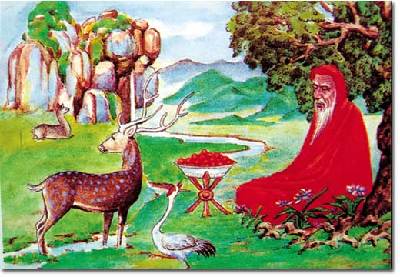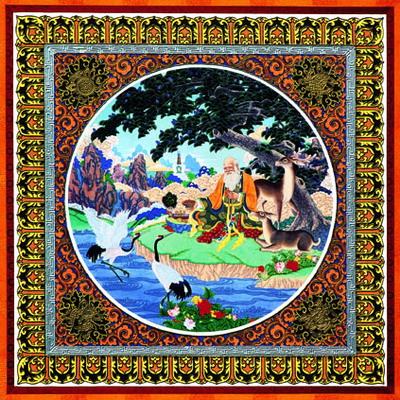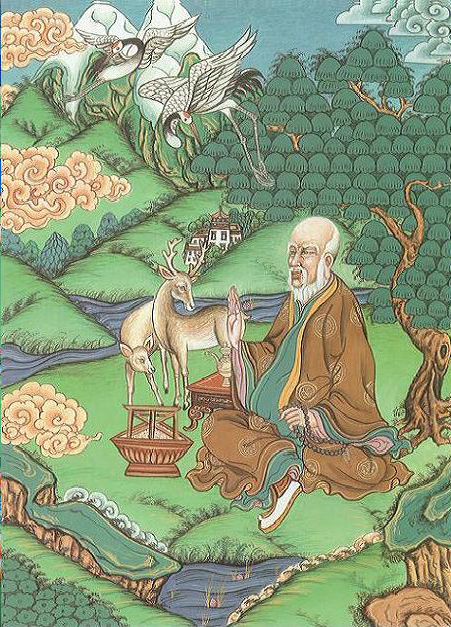
The painting of the "six symbols of longevity" is quite common in the fresco of monasteries and on the walls of Tibetan families. It is a typically traditional Tibetan motif. With bright colors, the painting is attractive and unique in terms of style, content, and design. The painting refers to a very old legend about an extremely beautiful and tranquil place where people dream to be, a cloud-kissing, firm and eternal Stone Mountain which, like the right-turning conch was worshiped by Amitayus; "a longevous old man" with a large, plump forehead and a long white beard on his face, benevolent in appearance and holding an ancient precious bottle and holy peach. He is living happily in the charming landscape. The hot spring, worshiped by the old man, is welling up from the valley of the Stone Mountain and flowing eternally to foster good health; an old tree living on this land and nourished by the hot spring is deeply rooted in the earth and appears to be flourishing and fruitful. It is a sacred place for people to enjoy the cool atmosphere; cranes are also living in this abundant land, shadowed by the ancient tree, fed with eternal fruits, and looked after by the old man. They happily search for food in his yard, which attracts various kinds of birds and beasts. On the grassland, not far from the old man, a buck and a doe are romping; having been protected by the old man, they are enjoying the profuse grass and abundant spring water.

Painting of "Six Symbols of Longevity". Painted Amdo Changpa
This traditional painting is acknowledged as a highly valued artwork with profound philosophical connotations and is treasured by people living at Tibetan inhabited areas.
Why do ethnic Tibetans love this painting? If we use contemporary ideology to read the profound contents and mysteries of the story, we could soon discover that our Tibetan ancestors had already been enriched with an awareness of environmental protection very early in their history. With sharpened eyes, they have totally embraced the balanced relationship between ecological systems. What a surprise! As is known, the "six longevity symbols" are respectively referred to as "longevous cliff", "longevous old man", "longevous tree", "longevous water", "longevous crane" and "longevous deer". All of them are closely and mutually connected.
Tibetans believe that the "longevous cliff" is composed of the land, people, and Stone Mountain. The "Stone Mountain" refers to solidity and eternity. Prayers for longevity of land and mountains by ancestors of Tibetans are seen as meaning that the land and mountains needed to be protected. The globe provides mankind with the natural environment and resources, which human beings depend on to live and develop. But it is unquestionable that mankind should not compromise these resources for the sake of grasping short-term benefits. If they do so, weather and geographic catastrophes will become more frequent in this land, thus human beings will destroy their own natural environment and eventually wipe themselves out. Actually, the old man in the painting refers to all human beings. So long as the ancient land exists, human beings could survive forever. It is a symbiotic relationship between the two. Beyond this, a balance of "longevity" should be taken into consideration too. For example, the third symbol "longevous water" appears. Water is the vital origin of all flesh. Neither human beings nor other live-forms will survive without water.

The "longevous tree" in the painting expresses the vegetation in the land that needs to be permanently living through its vital force. The tree is the "number one" form of vegetation on the earth. All plants together are the skin of the earth. Only by fully protecting the "skin" can all life be guaranteed. The nourishing forces of "longevous water" ensure the "longevous tree" will continue to flourish. The "longevous crane" refers to the birds that are living around the homestead of mankind. They are all friends of humanity. To depict the scene in which the old man takes care of the longevous crane, perfectively introduces the idea that human beings should look after birds so that a harmonious society could exist and bird species could survive throughout time. The long-living beast in the painting symbolizes that all kinds of fauna are the neighbors of mankind and that they all need to be protected by humanity.
The "six symbols of longevity" inspires peoples of the world to cherish all life on the earth and sustain it in a harmonious state in order to maintain ecological balance. Only by taking this approach, can the environment where humanity lives be protected. An ecologically balanced system could make a sustainable and pleasant homestead possible and finally the ideology of "six longevities" could become a reality.
We Recommend:
